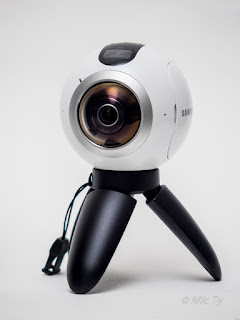Which is the best 360 camera for a vacation?
If you're going on a vacation, a 360 camera is a must-have for your trip. But there are now several 360 cameras on the market. Which one of them would be the best?
The best 360 camera depends on your specific needs:
If you are just starting out and want the most affordable 360 camera, that would be the LG 360 Cam (originally $199, on sale for $99; reviewed here). The LG 360 Cam is compatible with both iOS and Android. Photos are stitched in-camera, while videos are stitched on your smartphone via an app. It has decent image quality for both photos and videos. However, in low light, there is a lot of chroma noise. You also need to keep it charged at night because the battery drains even during standby.
If social media is important to you, and you'd like to be able to share photos and videos easily, and even do a livestream in 360, the best camera at the moment is the Insta360 Nano ($199; reviewed here). The Nano connects to your iPhone, and in addition, it stitches photos and 3k videos in realtime in-camera, making it easy to review your photos and videos, and to share them. Another alternative is the upcoming Giroptic iO for iPhone ($249; previewed here), which offers similar features but is compatible with a wider range of iOS devices, although at a lower 1920 x 960 video resolution. .If you have an Android phone, check out the upcoming Insta360 Air ($119 MSRP, $99 on preorder; previewed here), which has similar image quality as the Nano, at almost half the price, although it cannot be used independently from a phone.
If you want great photography, especially night sky photography, Ricoh Theta S ($349; reviewed here). The Theta has a very slim form factor that enables it to have the best stitching among all 360 cameras. In addition, it has extensive exposure controls. For night sky photography, it has new features such as an interval composite. If night sky photography is not important to you, you can save a little bit while still having many of the Theta S' advantages with the Ricoh Theta SC ($299; preview here). However, please note that both Theta S and Theta SC have a limited video resolution of 1920 x 960.
If you want the best video quality and are prepared to tackle the difficulties of using a rig, the Kodak SP360 4k ($799; reviewed here) currently has the best video quality among consumer cameras I've tested, with respect to both its optics and its sensor. However, one drawback is that the lenses are farther apart therefore the stitching will be more apparent for anything closer than about 10 feet. An even more significant consideration is that it really is a rig, and is therefore more complex than other consumer 360 cameras, with more ways of making mistakes and losing a video.
If you have a Samsung Note 5, S6 series, or S7 series, and you want a balance of good photo and video, the Samsung Gear 360 (Originally $349, now on sale for $299; reviewed here) is very good choice. The Gear 360's stitching is very good, second only to the Theta, and it has good photos and videos, with among the best edge-to-edge consistency in sharpness. The challenge is that photos and videos are not stitched in-camera, and unless you have an S7 series, you'll need a desktop to get the full resolution of the video. It's therefore less convenient for sharing 360 videos until you get back home. But you should be able to share 360 photos (after stitching them in the smartphone app).
There's no 360 camera that's bombproof, but if you want one that is waterproof to 30 feet, shockproof to 6 feet, and has a replaceable front element, look no further than the Nikon Keymission 360 ($499; reviewed here). Like the Gear 360, the Keymission has good photos and videos, but differs from the Gear 360. While the Gear 360 has great edge-to-edge consistency across the frame, the Keymission is very sharp near the middle of each lens (the sharpest among cameras I've tested) but the sharpness drops as you move close to the edge of the lens. For some users, that's a dealbreaker, while for others it won't matter. The Keymission stitches its photos and videos in-camera, but this convenience is offset by the difficulty in connecting to a smartphone.
In my case, I'm going on a cruise. I considered using the Insta360 Nano for its ease of sharing photos and videos, but the ship won't have a good Internet connection, so I won't be able to take advantage of that capability. At the same time, I'm hoping to be able to take some photos and videos at the swimming pool, so I decided to bring the Keymission 360. Besides the fact that it's waterproof, it's also good that it has an external battery. As a backup camera, I'm bringing the Ricoh Theta S, which I'm also planning to use for photography, or possibly even night sky photography. I'll post a few photos and videos from my trip when I return.










Comments
Post a Comment